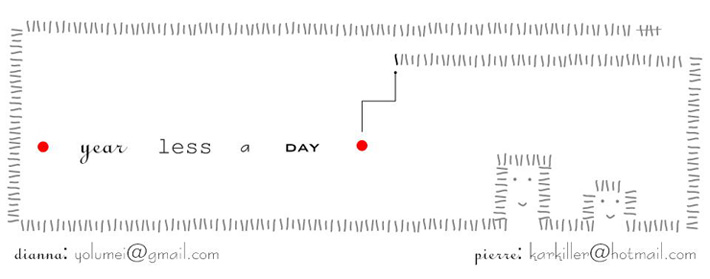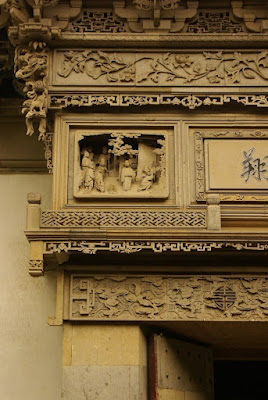The end of May brings another long weekend - this time a Thursday off - so Pierre reschedules his Friday and Monday (Tuesdays are always free) and we set up six day trip to Shanghai.
Getting from A to B always involves the usual transportation shuffle – here it’s a city bus from our apartment to the airport bus terminal, a long-distance bus to the Shenzhen airport, and a domestic carrier Shenzhen to Shanghai Hongqiao airport.
At most airports, we count on finding two things: A) a general information desk for tourists where we can get a map and some relatively disinterested (non-commission) advice on how to get to city center and B) a shuttle or public transport from the airport to somewhere downtown for a reasonable price. When we arrive, Hongqiao (sounds like HONG-chee-ow) Airport seems to have neither. The girl at the hotel and taxi information desk says that, from the airport, there’s no way to get a public bus to the Jing’An temple near our hostel. She recommends a taxi to the city center for about 200 kuai (sounds like kw-eye, rhymes with why – approximately 40$CAN).
The guidebook doesn’t say anything useful – the few city buses it mentions don't go anywhere near where we want to be. We’re pretty sure there’s got to be a middle ground between expensive/convenient (taxi) and cheap/indirect (any old city bus).
There are a few buses out front, but the signs are in Chinese only and there’s no sign of the Chinese characters for “Jing’An temple.”– a friendly passerby points us to a bus with no number, whose hostess says that yes, they go to/near Jing’An. We get on, figuring that, at the very least, wherever it drops us off we can walk to a metro stop and get ourselves to the right area. Since we’re not really sure where it goes, I follow the buses route on the map with my finger until it drops us off directly in front of Jing’An temple, a short 7 minute walk from our hostel, the Le Tour Traveler’s hostel.
Total cost: 4 kuai (80 cents) each.
This sets the stage for a relatively inexpensive trip. While planning the trip, we expect Shanghai to be expensive, but things work out in our favour. (This also set the stage for us noticing the entire trip how little we are spending on things, or how much we would have spent if we were interested in doing a particular thing, hence all the prices that are mentioned in this post.)
For our first 3 nights in the hostel, we’re upgraded for free to a deluxe room due to overbooking. For food, we stick to simple, cheap good food – in the morning there are the fried stuffed pitas for breakfast (1 kuai/20 cents per pita) from the street-side kiosks; lunch and dinner are usually at nearby canteens for about 8 kuai (1.50 $CAN) each per meal. This lets us treat ourselves a few times without going over budget.
We’re not much for drinking when we travel – beer is usually over-priced and more dehydrating that it’s usually worth in a hot climate. But when we stumble across The Bund Brewery, a pub that serves a local microbrew, we decide to splurge. We discover it’s possible to buy mugs by the litre-glass, so we do. (Comes to 88 kuai/16$CAN and worth every jao/penny.)
Me and my hat head waiting for Pierre to take the picture so we can have a sip…

…and Pierre diving in.

Living up to its name, the Bund Brewery is located in the Bund, which is the central riverside area of Shanghai. It used to be a kind of Chinese Wall Street in the early 1900s, and the area is known for its architecture and waterfront.
We walk around the area awhile, but to us the buildings remind us of the Sparks Street area of Ottawa. Though it’s pretty, we don’t feel the need to take any pictures or stick around for very long.
Plan B is to walk along the waterfront and enjoy the view – from the west side we can see odd bulb-shapes of the Oriental Pearl Tower – a tv tower and tourist lookout, most likely with a restaurant or café at the top. (At 250 kuai per person, we avoid the trip to the top so we’re not really sure what’s up there.)
Other than that we don’t see much of the waterfront. In preparation for Shanghai’s Expo 2010, the length of the waterfront is under construction and boarded off entirely – it’s so well boarded-off that without the map I probably wouldn’t know for sure if there was water on the other side of the fence. On the west side, the closest we get to the water is this:

Around the city are posters advertising the Expo and showing plans for some of the country pavilions. My knowledge of Expo’s is pretty slim, but from what I remember it’s usually a big showcase for bold architectural design. 2010 is no different – most of the pavilion plans are pretty ugly and like someone designed on a dare.
- Canada: looks like a bit of a mess (it looks like even more of a mess on the Canada site)
- Spain: kind of neat with a bread-basket look
- Czech Republic: looks like a superstore
- UK and Switzerland are equal parts interesting and baffling.
(If you scroll down here you’ll see more examples.)
I wonder how these buildings are going to fit in with the rest of the city, which is already quite a mix of styles all within a short walk of each other – from the 1930’s New York styles of the Bund, to the Art Deco apartment blocks in the French Concession, to the Old Town with its narrow alleys and old low buildings.
We spend a few hours walking through the Old Town, with its low improvised awnings for shade…


…its bright corners…

 …and dim narrow alleyways:
…and dim narrow alleyways:
 On Day 209, we attempt to visit a couple of museums: the Propaganda Poster Art Centre and the China Sex Culture Museum. As always, walking lets us get from A to B while seeing the city at the same time, so we head out on foot and our quest to find the museums takes a few hours. Today, it turns out, is kind of a write-off. One museum is not where the guidebook says it is, and the other has been moved out of Shanghai.
On Day 209, we attempt to visit a couple of museums: the Propaganda Poster Art Centre and the China Sex Culture Museum. As always, walking lets us get from A to B while seeing the city at the same time, so we head out on foot and our quest to find the museums takes a few hours. Today, it turns out, is kind of a write-off. One museum is not where the guidebook says it is, and the other has been moved out of Shanghai.
We try to salvage the day by finding our way to the south-west of Shanghai via city bus to the ancient town of QiBao (sounds like chee-bow, rhymes with me-wow). The location of the bus pick-up point eludes us for about an hour, and the bus ride takes a while. When we finally arrive at the QiBao bus stop, the town is not located where the map says it is and we have to wander around for awhile to find it. Once we finally get to QiBao proper, we're too tired to do anything but walk around for an hour and eat dinner.
The ever-excellent Shanghai metro (cheap, prompt, clean) now goes as far as this area, something that wasn’t true at the time our book was printed (hence the tedious bus ride here.) The ride home on the metro is fast.
We wrap up our day by early evening – our trip for the past several months has gone fairly smoothly and we’re not too worried to lose a day to a series of mix-ups. If anything, we figure our trip has gotten it out of its system for awhile...
We hang out in the room and plan tomorrow’s day trip to nearby Tong Li.

































































